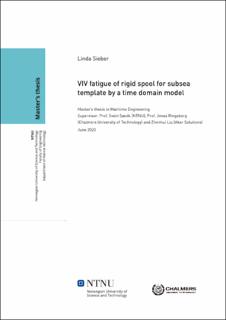| dc.description.abstract | Subsea spools and jumpers are commonly placed close to the seabed where they are
exposed to low velocity currents. These currents lead to vortex induced vibrations
(VIV) in in-line (IL) and cross-flow (CF) direction. VIV can lead to fast accumulation of fatigue damage and the prediction of VIV is therefore important in fatigue
assessment of those structures.
In this thesis work, a typical ’M’-shaped jumper model was investigated. Due to
the three-dimensional geometry, VIV predictions for spools and jumpers are more
complicated compared to straight pipes, both from hydrodynamic and structural-dynamic perspective. The tri-axiality of flow makes it difficult to separate into IL
and CF response, but it is crucial to understand which modes are active in VIV
response. On a structural level, the stiffness is affected by bent pipe elements due to
deformation of the cross-section and additional strains. The special considerations
that must be made in analysis of spools and jumpers are pointed out in the literature
study.
Further, two models were investigated, which differed only in the element type
used to model the 90-degree pipe bends. One of these was a simple linear-elastic
pipe element, while the other one was an elbow element, capable of accounting for
deformation of the cross-section and additional strain terms due to bending. This
allowed for evaluation of the importance of change in stiffness on modal analysis.
Two software packages were used to verify the eigenvalue results and the use of
elbow elements: Simla, developed at NTNU Trondheim, and Abaqus, developed by
Dessault Systèmes ®. It was shown that the reduced stiffness of the model including
elbow elements improved the results of modal analysis, especially with regard to
in-line bending, and caused a shift in the mode shape order.
Flexibility factors for a full-scale bend model including internal and external pressure were evaluated.
TD VIV simulations for different load cases were carried out in Simla. With this
TD tool it was possible to account for large deflections and time-varying flow. A
parameter study was conducted on the input parameters in Simla, especially for
the TD VIV prediction tool. The results from VIV motion were compared to the
empirical response model approach from DNVGL-RP-F105 (2019) and to experimental data.
With varied parameters of the TD VIV tool it was possible to obtain results that are
in good correlation with model test data. The DNV GL response model approach
for many cases gave very conservative motion amplitudes, especially for CF VIV,
compared to experimental data.
Stresses and fatigue damage from VIV were calculated by two different methods, of
which one used the moment signals obtained from the VIV tool in Simla directly
and applied rainflow counting to find stress ranges. The other method followed the
response model approach from the recommended practice DNVGL-RP-F105 (2019).
For this latter method, modal analysis results were used together with response amplitudes obtained from the guidelines. For both methods the maximum principal
stress criterion was used for equivalent stresses. Fatigue damage was calculated using the SN-data from DNVGL-RP-C203 (2005).
For most cases the fatigue damage calculated using the DNV GL response model procedure was higher than obtained from the TD tool, which was expected since motion
amplitudes obtained from the guidelines were already very conservative. However,
for several load cases with low-velocity currents up to 0.3 m/s the Simla tool gave
higher fatigue estimates. These cases are due to IL VIV which occurs at low current
velocities and is especially relevant for structures placed close to the seabed. It was
also found that torsional stresses are relevant for observed flow directions and, thus,
cannot be neglected. Sensitivity of fatigue damage to changes of the drag coefficient
and model parameters of the VIV tool was discussed. Based on the findings of this
thesis work, recommendations for future work were made. | |
